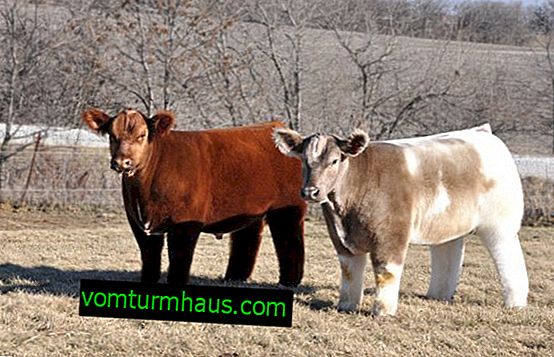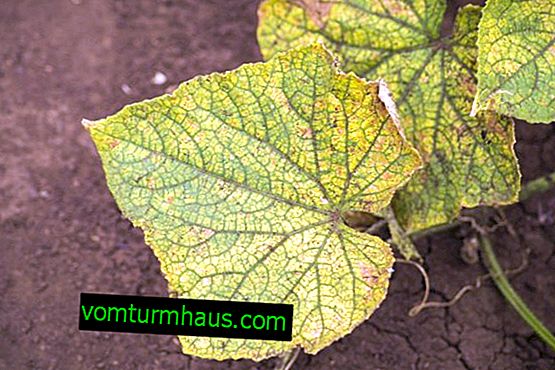Cow's teeth: their number, structure and causes of loss
The peculiarity of the anatomical structure of the stomach in cows is such that they must constantly chew food, as a result of which a large load is placed on their teeth. In this article, we will consider the structural features of cattle jaws, learn how to determine the age of the teeth and their possible diseases in cows.
The structure of the jaw of a cow
Cows belong to artiodactyl ruminants, therefore the structure of the oral cavity significantly distinguishes them from other livestock. Awareness of the owner about the features of tooth growth in cows helps to prevent the occurrence of diseases, improves productivity and can extend the life of the animal.
Did you know? Cows and bulls became ruminants during development. Due to the lack of fangs and claws, they were easy prey for predators, this influenced the formation of a special way of eating: pinch and swallow, then find a secluded place and chew in a peaceful environment.
Studying the structure of the jaw of this representative of cattle, it is important to note the need for lips, tongue and salivary glands in the process of grinding food. Lips and tongue help swallow and mix food, saliva makes it easy to send to the esophagus. From above, the jaw of the cow is slightly wider than from below, thanks to this, it chews food on the left and right sides of the mouth in turn. But the main work is done by the teeth.
Do cows have upper front teeth?
When examining the cow's mouth, it may seem that the upper row of teeth is missing. But this is not so, it has changed in the process of evolution and now looks like a strong wide plate, based on which hardened gums are located.

Location and number of teeth
How much a cow has teeth depends on the age of the animal and its care. Altogether, adult cattle have 32 teeth. On the lower jaw there are 8 incisor short-crowned teeth, behind which there are molars, behind them, from the top and bottom, 3 premolars and 3 molars on each side. Thus, the cow has 24 molars, each of which is long-crowned.
Tooth structure
Cow teeth are divided into two types according to their structure and structural features: incisors and molars. They differ not only in location in the oral cavity, but also in composition.
Incisor (short-crowned) teeth consist of:
- crowns with smooth enamel, at the bottom of which is dentin. Under it is the middle of the tooth with pulp consisting of nerves and blood vessels;
- cervix in the gum end zone;
- root in a cell-shaped cavity coated with a cement mixture. Under it is placed dentin and the root of the tooth, forming a hole that serves as a passage for veins, arteries and nerves.

The structure of molars (long-crowned teeth) has some differences:
- the neck of the tooth is absent;
- the crown consists of grayish cement and is embedded deep into the tooth, ending with a small part of the root, on which there is a gap leading to the cavity;
- enamel is under cement;
- inside the tooth is filled with pulp.
Teeth change
The process of erasing tooth enamel in cattle begins from the moment the calf is transferred from colostrum to more rigid foods: potatoes, hay and mixed feed. This becomes necessary at the age of 4–5 months for the proper creation and further functioning of the cicatricial section of the stomach.
Did you know? Over time, the crown of molars erases to the neck and advances forward. But this does not pose any danger, because the teeth of cows tend to grow continuously, therefore, even in perennial animals, some of them are preserved.

- refusal of the animal to eat rough food (this causes pain);
- excessive salivation;
- teething on the lower jaw;
- reduction in milk yield.
- the front teeth grind first, then the internal incisors and hooks, from which only stumps remain;
- the next are the middle incisors;
- at the age of one and a half years the same thing happens with fringes (an extreme pair of incisors, mutated fangs);
- on the place of the dropped out hooks molars grow.

How to determine the age of the teeth
When buying an animal, there are often cases when you need to determine its age. This can be done by examining the oral cavity, but you need to understand that calculating the age of a cow in the teeth cannot be absolutely correct. The condition of tooth enamel depends on the type of food that the animal was fed, and on the individual characteristics of development.
Important! When calculating the approximate age of the animal by the teeth, it is necessary to very carefully and carefully open the mouth of the cow. After all, if she feels pain at the same time, she can sharply clamp a massive jaw and bite a person’s hand. To determine the age of cattle, average indicators are used, which are given in the table:
| Age | Oral condition |
| 1 Week | 8 milk teeth. |
| 3 weeks | 3 teeth on the left and right on the lower jaw. |
| 3-4 months | The edges are fully formed. |
| 6 months | The 4th molar appears. |
| 1 year | Enamel disappears on the outer surface of the hooks. |
| 14 months | Enamel disappears on the inner surface of the hooks. |
| 2 years | Internal milk incisors fall out. |
| 3 years | Permanent milk incisors appear. |
| 4 years | Complete replacement of teeth occurs. |
| 5 years | Erase the upper margins. |
| 6 years | The hooks and inner middle teeth are erased. |
| 7 years | The enamel of the surface of the hooks disappears. |
| 10 years | Enamel disappears. |
| 11-12 years old | Incisors seldom set, claws hooked. |
| 13-14 years old | Enamel disappears completely. |
| 15-18 years old | Only stumps remain in the oral cavity. |
Possible diseases of the teeth and bison
The addition of components such as phosphorus and calcium to cattle food has positive effects only with the right dosage. But it happens that farmers overdo it, and the animal uses an increased amount of phosphorus, as a result of which he develops a disease such as fluorosis.
The enamel, which is shiny and white in a healthy cow, acquires a yellowish tint, and black dots appear on it. In this case, you can try to correct the situation yourself by reducing the amount of minerals in food and water.

If you notice changes in the external behavior of the burenka, it seems to you that its condition is somewhat dull, and the amount of milk has decreased, you should not worry, just the animal has a bison - the process of loss of upper teeth and replacing them with a tooth plate. In a cow, it begins at about the age of 2–2.5 years and lasts long enough.
The bison period is characterized by several signs:
- addiction of the animal to liquid and soft foods;
- the scar decreases slowly;
- high salivation;
- severe staggering of teeth;
- temperature rise.
If any of these symptoms suddenly manifests itself too expressively, you should consult a specialist for an examination.

All of the above in this article confirms the importance of careful monitoring of cattle owners over the diet of animals, the state of their oral cavity and well-being, because these are components of good productivity and long life of cows. Remember that awareness of the possibility of diseases is already their prevention.



